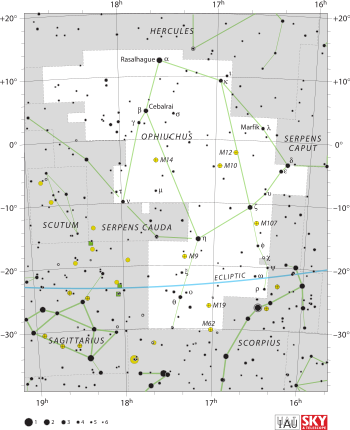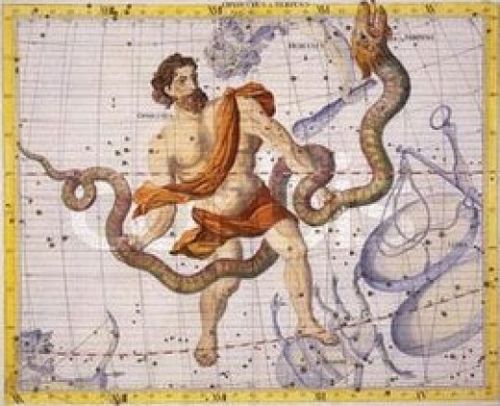Thirteenth Constellation
Ophiuchus is a large constellation straddling the celestial equator. Its name comes from the "serpent-bearer", and it is commonly represented as a man grasping a snake. The snake is represented by the constellation Serpens.
Ophiuchus was one of the 48 constellations listed by the 2nd-century astronomer Ptolemy, and it remains one of the 88 modern constellations. An old alternative name for the constellation was Serpentarius.
Location
Ophiuchus lies between the constellations of Aquila, Serpens, Scorpius, Sagittarius. Ophiuchus is depicted as a man grasping a serpent; the interposition of his body divides the constellation Serpens into two parts, Serpens Caput (the snake's head) and Serpens Cauda (the snake's tail).
History
The supernova of 1604 was first observed on 9 October 1604, near θ Ophiuchi. Johannes Kepler saw it first on 16 October and studied it so extensively that the supernova was subsequently called Kepler's Supernova. He published his findings in a book titled De stella nova in pede Serpentarii (On the New Star in Ophiuchus's Foot). Galileo used its brief appearance to counter the Aristotelian dogma that the heavens are changeless.
At the beginning of 1995, the international media reported that a thirteenth constellation and therefore sign of the sidereal zodiac between Scorpio and Sagittarius had been discovered: Ophiuchus or the Serpent Bearer. Opponents of astrology viewed this news as confirmation of their skepticism of astrology and declared the zodiac used by astrologers to be obsolete. The scientist Jacqueline Mitton from the Royal Astronomical Society of Great Britain was credited with making the discovery, but she later distanced herself from the claim that the 'Serpent Bearer' was a new astronomical discovery.[1] In actual fact, it can be found plotted in the same position on 2000 year old astronomical maps, but she nevertheless continued to hold that its existence meant that the astrological division into twelve signs had lost all legitimacy. The charge of a "thirteenth sign" ignored by astrologers re-emerged in 2011, with fresh criticism in the US from the Minnesota Planetarium Society, which its spokesman subsequently retracted.
The reference to a thirteenth constellation as an argument against astrology ignores the fact that even in Antiquity western astrology used an equal twelve-fold division of the ecliptic based on the astronomical relationship between the Sun and the Earth defined by equinoxes and solstices, i.e. the tropical zodiac. Due to the precession of the equinoxes the signs are no longer attached to the stars grouped into the constellations for which they were named. The constellation Ophiuchus occupies only a narrow band along the ecliptic, and its space is covered by the signs of Scorpio and Sagittarius.

Weblinks
- Wikipedia (Ophiuchus)
- Ophiuchus: the Serpent Bearer (Deborah Houlding, 1999/ 2008)
- Ophiuchus - the 13th Sign of the Zodiac? (Dieter Koch, Astrodienst)
- Ophiuchus puts his foot in it, but it's Cox who sticks the Boot in (Houlding, 2011)
- New Dates for Sun Signs? - Not in Astrology! (Houlding, 2015)

